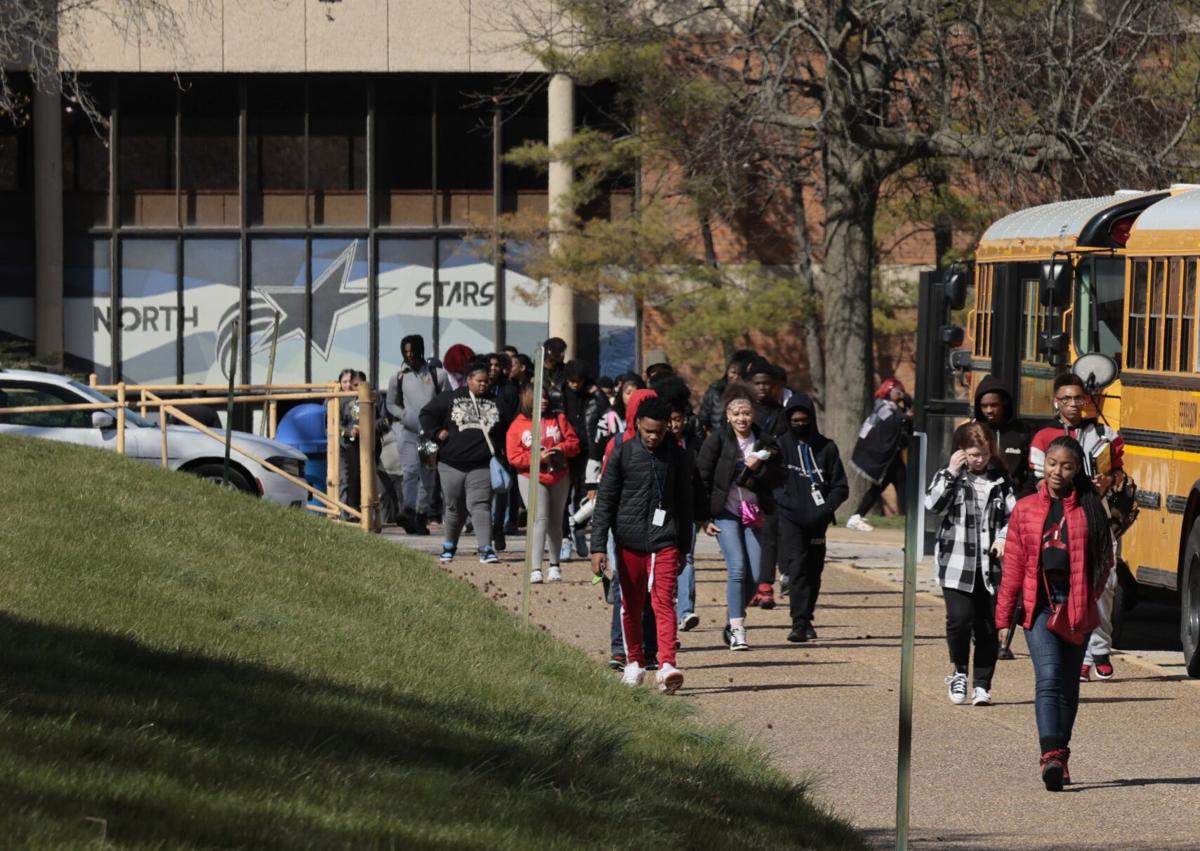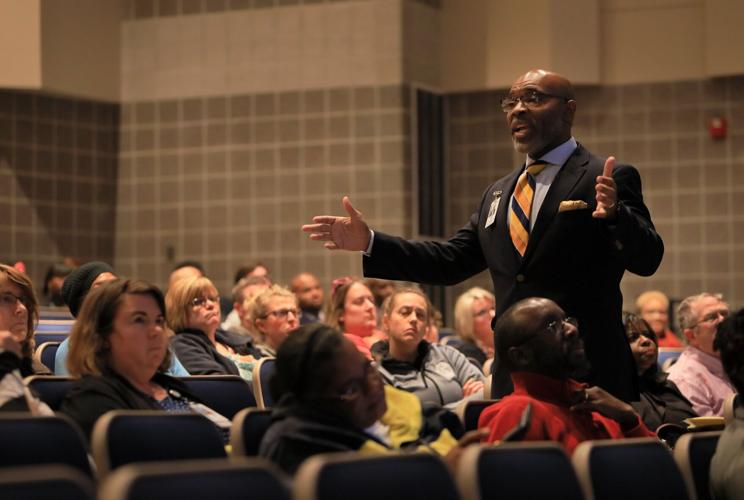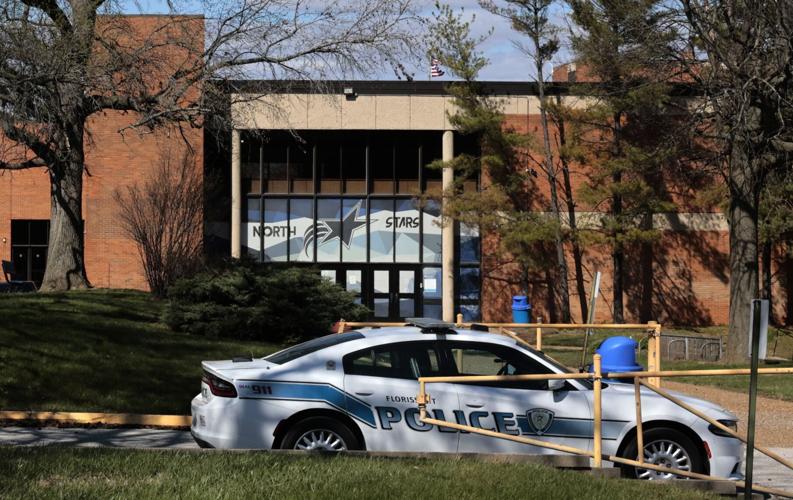FLORISSANT — When Doug Jackson’s daughter returned to school after the pandemic, she often called and asked him to pick her up early.
“There were fights all the time,” said Jackson, who’s had three children in the Ferguson-Florissant School District. “She was having panic attacks because of all the chaos.”
Violence and unruly behavior have dogged Ferguson-Florissant schools for years. But a few recent incidents garnered particular attention.
At McCluer North, several fights in one day in early February caused the building to be put under “precautionary lockdown.” The fights ended with one student’s arrest, and in-person classes were canceled the next day.
And at McCluer High, an attack at the school by two juveniles — a student and a former student — led to their off-campus arrests.
People are also reading…
Now, the district hopes a “reset” at McCluer North High School will help put one of its schools on a better track, as school districts across Missouri and the U.S. grapple with student violence. Experts say violent incidents among students have increased in recent years, resulting in a chaotic atmosphere for students and increasing difficulty in hiring and retaining teachers.
At Ferguson-Florissant, the district emphasized that the reset wasn’t necessarily an implementation of new programs, but rather a doubling-down of existing policies and procedures.
“You may notice a positive shift as we redouble our efforts in addressing behaviors that disrupt our school community, such as fighting, tardiness, dress code violations, bullying and inappropriate conduct,” Superintendent Joseph Davis said in a message to families last month.
Davis said in an interview he’s been working with teachers and staff to “relaunch expectations” and make greater use of an intervention and support system.
“We’ve been working really hard on our social-emotional tenets, helping them with the ability to resolve conflict,” Davis said.

Joseph Davis, superintendent of the Ferguson Florissant school district, addresses the crowd about the process the district will take as it decides which schools will be closed during a meeting at McCluer South High School on Monday, Dec. 4, 2017.
The district’s reset began shortly before two of its North County neighbors — Hazelwood School District and Jennings School District — saw high-profile cases of violence involving students, though both happened just off school grounds.
On March 8, Hazelwood East sophomore Kaylee Gain, was severely beaten in a fight that was captured on video and left her hospitalized in critical condition.
And four days later, 14-year-old Justin Brooks was stabbed and killed down the street from Rose Mary Johnson Jennings Junior High School. Brooks, a “star athlete,” was a leader on his city recreational league team.
Some education experts point to the COVID-19 pandemic — and students’ return from virtual learning — as a cause of behavioral changes in schools.
Locally, data seems to support that. A Post-Dispatch analysis of data from the Missouri Department of Elementary and Secondary Education shows that, since the pandemic, school districts in St. Louis County are disciplining students more than they have in a decade.
In 2022, the annual rate of discipline incidents per 100 students across St. Louis County, 2.8, was the highest rate since 2012. The data reflects incidents where a student was removed from a classroom for 10 or more consecutive days.
And some districts have seen even more significant changes. Since the pandemic, Affton, Hancock Place, Jennings, Normandy and University City school districts all recorded their highest yearly discipline rates since at least 2001.
One or both of the post-pandemic years 2022 and 2023 marked their highest discipline rates since at least 2001.
Meanwhile, the state’s undermanned arsenal of teachers report difficulties dealing with student behavior.
In a recent survey of more than 2,300 Missouri teachers and administrators, stress and student behavior were tied for the top reasons respondents considered leaving education. The answers beat lack of pay, burnout and workload.
Getting to the root
School districts nationwide have increasingly scrutinized the effectiveness of “exclusionary” disciplinary practices such as in-school or out-of-school suspensions in recent years. At Ferguson-Florissant, which in the past received flack for its handling of long-term suspensions, the rate of discipline incidents has decreased significantly in recent years.
Such punishments are now used only as a “last resort,” according to the district’s most recent student expectation code.
Instead, the district, like many others, has gravitated toward so-called restorative practices, which focus less on suspensions and more on conflict resolution.
The general aim is to help students learn from their mistakes and repair relationships — instead of taking them out of classrooms, James Shuls, graduate program director of educational leadership and policy studies at the University of Missouri-St. Louis, said.
“It’s like taking ownership for problems and trying to correct them, rather than just punitive consequences,” Shuls said.
Restorative practices take many forms. They can involve class meetings, community service, conflict-resolution programs, peer mediation and small-group counseling.
Several St. Louis-area school districts, including University City, Rockwood, Riverview Gardens, Kirkwood, Ferguson-Florissant and Hazelwood — where the sophomore was severely beaten — have embraced the use of restorative practices.
Support for restorative practices is substantial but divided. Advocates view them as a way to break the school-to-prison pipeline and ensure equitable discipline. Critics feel they allow students to misbehave with impunity.
Davis, Ferguson-Florissant’s superintendent, emphasized in an interview that restorative practices are just one strategy his district uses to improve behavior. Ferguson-Florissant will “absolutely still give consequences when kids are not behaving appropriately,” he said.

A Florissant police car sits in the parking lot before students are dismissed on Monday, March 18, 2024, at McCluer North High School in Florissant.
But after the consequence, administrators then look for the root cause of bad behavior.
Fighting is just a “symptom,” Davis said.
“We are finding students don’t always know how to connect in socially appropriate ways,” Davis said. “This is for a variety of reasons: COVID, technology, overexposure to social media, you name it.”
‘Schools can’t do it alone’
More than 80% of public schools in the U.S. reported the pandemic negatively impacted student behavior and development, according to the National Center for Education Statistics. And nearly 70% of public schools reported that the percentage of students who have sought mental health services increased since the start of the pandemic.
“Students haven’t been able to develop the social skills to engage with one another in productive manners,” said Shuls, the director at UMSL. “It can lead to very negative outcomes where they haven’t learned how to resolve conflict.”
Davis said many students in the districts have struggled to deal with emotions or regulate themselves since the pandemic.
“I think a lot of it came from them being isolated,” Davis said. “It’s important for students to build friendship networks when they’re in school.”
But even before the pandemic, Ferguson-Florissant made moves to improve student behavior.
To cut down on distractions, middle and high school students are required to put their phones in locked Yondr pouches at the beginning of school. Magnetic detectors at school exits open the pouches at the end of the day.
And beginning last fall, kindergarten through fifth-grade students started wearing uniforms. Davis said middle and high school students will do the same next school year.
The reset at McCluer North appears to accompany new leadership up top. Kurtis Downing was appointed as interim principal of McCluer North for the remainder of the school year, according to a message sent to the school’s community in February.
The current role of Frank Williams, who’s still listed as principal of McCluer North on multiple district webpages, is unclear. Davis declined to comment on Williams, and a spokesperson said Williams still works for the district.
Davis noted that the district can try its best, but real change for students can happen only if it also comes from home, too.
In December, Davis held a community meeting with parents at a time when the district dealt with another spate of fights.
Fighting is bigger than school, he said. Parents have to step in.
“Schools can’t do it alone,” Davis said.
Chris Gaines, chief executive officer of local school resource nonprofit EducationPlus, said the recent high-profile fights at Jennings and Hazelwood are rare and extreme — “but even one instance of that is one too many.”
“It makes you question what kind of examples that adults today are setting for young people to resolve conflict,” he said. “Are we too interested in filming something to go viral to help people?”
Josh Renaud of the Post-Dispatch contributed to this report.
St. Louis Post-Dispatch photographers captured February 2024 in hundreds of images. Here are just some of those photos. Edited by Jenna Jones.























